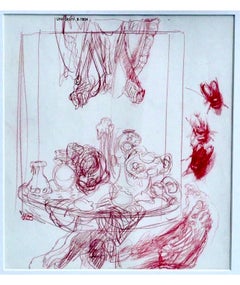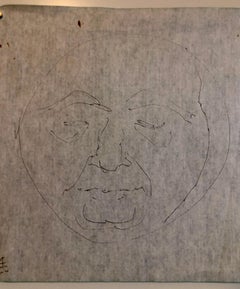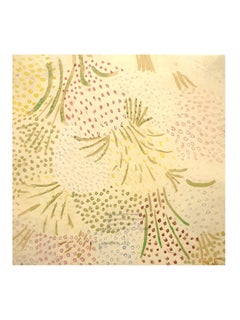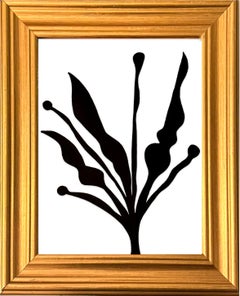Hyman Bloom Drawings and Watercolor Paintings
to
2
Overall Width
to
Overall Height
to
2
1
1
1
1
1
2
1
1
3
917
406
282
279
1
2
Artist: Hyman Bloom
Boston Expressionist Conte Pencil Drawing "Still Life with Flies" Hyman Bloom
By Hyman Bloom
Located in Surfside, FL
Hyman Bloom
"Still Life with Flies"
Frame: 18" X 16"
Image: 9.25" X 8.25"
Hand signed with his monogram initials
Provenance: bears exhibition label from Fuller Museum of Art
Hyman B...
Category
1990s Abstract Hyman Bloom Drawings and Watercolor Paintings
Materials
Color Pencil
Boston Abstract Expressionist Hyman Bloom Original Pencil Drawing Martin Sumers
By Hyman Bloom
Located in Surfside, FL
This is a unique artwork. This is an original Hyman Bloom drawing of fellow artist and his very good friend Martin Sumers.I believe this was drawn at the “variations of a theme” at S...
Category
20th Century Modern Hyman Bloom Drawings and Watercolor Paintings
Materials
Paper, Pencil
Related Items
Sonia Delaunay - Original Watercolor on paper
By Sonia Delaunay
Located in Collonge Bellerive, Geneve, CH
Sonia Delaunay - Original Watercolor on paper
Dimensions: 21 x 21 cm.
Authentified by her son Charles Delaunay on the back.
Sonia Delaunay was known for her vivid use of color and her bold, abstract patterns, breaking down traditional distinctions between the fine and applied arts as an artist, designer and printmaker.
Born Sarah Stern on November 14, 1885 in Gradizhsk, Ukraine, she was adopted in 1890 by her maternal uncle, Henri Terk, a lawyer in St. Petersburg, where she grew up, exposed to music and art, and learning several foreign languages. In 1903, she moved to Germany to study drawing with Ludwig Schmidt-Reutler (1863–1909) at the Karlsruhe academy of fine arts; Arnold Schoenberg (1874–1951), composer-to-be, was among her classmates there. In 1905, she traveled to Paris where she attended art classes at the Académie de la Palette, learned printmaking from Rudolf Grossman (1889–1941), and met Amédée Ozenfant (1886–1966), André Dunoyer de Segonzac (1884–1974), and Jean-Louis Boussingault (1883–1943). Sonia spent much of her time at exhibitions and galleries in Paris, which showed works by Paul Cézanne, Vincent Van Gogh, Pierre Bonnard, and Edouard Vuillard, as well as Les Fauves, Henri Matisse and André Derain. She did, however, maintain contact with Germany, exhibiting at the Galerie Der Sturm, Berlin, in 1913, 1920 and 1921.
During her first year in Paris, Sonia met the German collector and art-dealer, Wilhelm Uhde (1874–1947), whom she married on December 5, 1908, and whose Montparnasse gallery, the Galerie Notre-Dame des Champs, showed her first solo exhibition. Through Uhde, Sonia encountered many painters, including Pablo Picasso, Georges Braque, Maurice de Vlaminck, and Robert Delaunay (1885–1941). In 1910, Sonia divorced Uhde by mutual agreement, married Delaunay that same year, and gave birth to their son, Charles, in January 1911.
Together Sonia and Robert Delaunay pursued the study of color, influenced by theories of Michel-Eugène Chevreul (1786–1889). Sonia’s interest in simultaneous contrast, as evidenced in her early collages, book bindings, small painted boxes...
Category
1930s Abstract Geometric Hyman Bloom Drawings and Watercolor Paintings
$4,983
H 8.27 in W 8.27 in D 0.04 in
Bountiful
Located in Brooklyn, NY
This black and white abstract drawing features a beautiful floral.
Framed in a vintage gold frame, wired and ready to hang, 11 in. wide x 13 in. high
Category
2010s Abstract Hyman Bloom Drawings and Watercolor Paintings
Materials
Archival Ink
Abstract Geometric Terracotta Jugs, Mid Century Modern Abstracted Still Life
Located in Soquel, CA
Bold mid century modern abstracted pastel on paper still life of several terra cotta jugs and vessels distilled down to their most basic shapes and ar...
Category
1960s Abstract Geometric Hyman Bloom Drawings and Watercolor Paintings
Materials
Paper, Pastel
$595 Sale Price
30% Off
H 24.25 in W 29.75 in D 1.25 in
Red Flowers Abstract Still Life
By Les Anderson
Located in Soquel, CA
Abstracted still life of a vase of red flowers and fruit blending into an abstract expressionist watercolor composition by Les Anderson (American, 1928-2009). Signed "Les Anderson" l...
Category
1980s Abstract Expressionist Hyman Bloom Drawings and Watercolor Paintings
Materials
Paper, Watercolor
Untitled Floral Still Life
Located in Wilton Manors, FL
Beautiful floral still life by American artist Jane Piper (1916-1991) . Pastel, oil crayon and pencil on tracing paper. Image measuring 13 x 15.5 inches in ...
Category
1980s Abstract Hyman Bloom Drawings and Watercolor Paintings
Materials
Parchment Paper, Crayon, Pastel, Pencil
Portrait of a Young Woman - 1900s - René François Xavier Prinet - Drawing
By René Francois Xavier Prinet
Located in Roma, IT
Portrait of A Young Woman is an original artwork realized by the French artist and illustrator René François Xavier Prinet between the end of the XIX and the beginning of the XX cent...
Category
Early 1900s Modern Hyman Bloom Drawings and Watercolor Paintings
Materials
Paper, Pencil
René Francois Xavier PrinetPortrait of a Young Woman - 1900s - René François Xavier Prinet - Drawing
$237
H 12.6 in W 9.45 in D 0.08 in
Mon Colonel
By Auguste Chabaud
Located in London, GB
'Mon Colonel', pencil and crayon on paper, by noted French artist, Auguste Chabaud (circa 1914-1918). A delightfully simple drawing of a French Army colonel in profile along with clo...
Category
1910s Modern Hyman Bloom Drawings and Watercolor Paintings
Materials
Paper, Crayon, Pencil
Female Face - Drawing by Henri Epstein - Early 20th Century
Located in Roma, IT
Female Face is an Pencil Drawing realized by Henri Epstein (1892-1944).
Good condition on a yellowed paper, included a white cardboard (50x35 cm).
Hand-signed by the artist on the lower right corner.
Henri Epstein born in Lódz ( Russian Empire ) on January 14 , 1891 where theJune 20 , 18922 , 3 and died in deportation to Auschwitz ( Third Reich...
Category
Early 20th Century Modern Hyman Bloom Drawings and Watercolor Paintings
Materials
Paper, Pencil
$450
H 12.21 in W 9.06 in D 0.04 in
Untitled Floral Still Life
Located in Wilton Manors, FL
Beautiful floral still life by American artist Jane Piper (1916-1991) .
Untitled. 1980.
Pastel, oil crayon and pencil on tracing paper. Image measuring 9 x 12 inches in original ...
Category
1980s Abstract Hyman Bloom Drawings and Watercolor Paintings
Materials
Parchment Paper, Crayon, Pastel, Pencil
Colorful Expressionist Still Life with Watermelon and Pears
By Les Anderson
Located in Soquel, CA
Vivid watercolor still life with colorful expressionist pink and purple hues, of a bright table with watermelon, pears, and flowers on heavy paper by Monterey artist Les Anderson (Am...
Category
Early 2000s Abstract Impressionist Hyman Bloom Drawings and Watercolor Paintings
Materials
Paper, Watercolor
$276 Sale Price
35% Off
H 14 in W 20 in D 0.03 in
Portrait of Benito Mussolini - Drawing by Alberto Manetti - 1920s
Located in Roma, IT
Duce Portrait is a modern artwork realized by the artist Alberto Manetti (known also as Brivido).
Pencil and charcoal on paper.
Hand signed on the higher right margin.
Inscription...
Category
1920s Modern Hyman Bloom Drawings and Watercolor Paintings
Materials
Paper, Charcoal, Pencil
$711
H 12.09 in W 8.67 in D 0.04 in
"Biomorphic Flowers" original watercolor painting by Sylvia Spicuzza
By Sylvia Spicuzza
Located in Milwaukee, WI
In the 1960s, Sylvia Spicuzza made several watercolor abstractions with biomorphic qualities like the one presented here. This example takes on the appearance of a flower, while the ...
Category
1960s Abstract Hyman Bloom Drawings and Watercolor Paintings
Materials
Watercolor
$2,500
H 15.5 in W 17.87 in
Previously Available Items
Boston Abstract Expressionist Hyman Bloom Original Pencil Drawing Martin Sumers
By Hyman Bloom
Located in Surfside, FL
This is a unique artwork. This is an original Hyman Bloom drawing of fellow artist and his very good friend Martin Sumers.I believe this was drawn at the “variations of a theme” at Sumers gallery in NYC. The last two photos show a poster and a card from their shows. it is not included in this listing, it is just for provenance.
Provenance: Acquired from the Sumers estate collection.
Hyman Bloom (March 29, 1913 – August 26, 2009) was a Latvian-born American painter. His work was influenced by his Jewish heritage and Eastern religions as well as by artists including Altdorfer, Grünewald, Caravaggio, Rembrandt, Blake, Bresdin, James Ensor and Chaim Soutine. He first came to prominence when his work was included in the 1942 Museum of Modern Art exhibition "Americans 1942 -- 18 Artists from 9 States". MoMA purchased 2 paintings from the exhibition and Time magazine singled him out as a "striking discovery" in their exhibition review.
His work was selected for both the 1948 and 1950 Venice Biennale exhibitions and his 1954 retrospective traveled from Boston's Institute of Contemporary Art to the Albright Gallery and the de Young Museum before closing out at The Whitney Museum of American Art in 1955. In a 1954 interview with Yale art professor Bernard Chaet, Willem de Kooning indicated that he and Jackson Pollock both considered Bloom to be “America’s first abstract expressionist”, a label that Bloom would disavow. Starting in the mid 1950s his work began to shift more towards works on paper and he exclusively focused on drawing throughout the 1960s, returning to painting in 1971. He continued both drawing and painting until his death in 2009 at the age of 9
Hyman Bloom (né Melamed) was born into an orthodox Jewish family in the tiny Jewish village of Brunavišķi in what is now Latvia, then part of the Russian Empire
At a young age Bloom planned to become a rabbi, but his family could not find a suitable teacher. In the eighth grade he received a scholarship to a program for gifted high school students at the Museum of Fine Arts. He attended the Boston High School of Commerce, which was near the museum. He also took art classes at the West End Community Center, a settlement house. The classes were taught by Harold Zimmerman, a student at the School of the Museum of Fine Arts, who also taught the young Jack Levine at another settlement house in Roxbury. When Bloom was fifteen, he and Levine began studying with a well-known Harvard art professor, Denman Ross, who rented a studio for the purpose and paid the boys a weekly stipend to enable them to continue their studies rather than take jobs to support their families.
He took Bloom and Levine on a field trip to the Museum of Modern Art in New York, where Bloom was impressed by the work of Rouault and Soutine and began experimenting with their expressive painting styles.
In the 1930s Bloom worked sporadically for the Public Works of Art Project and the Federal Art Project (WPA), He shared a studio in the South End with Levine and another artist, Betty Chase. It was during this period that he developed a lifelong interest in Eastern philosophy and music, and in Theosophy.
He first received national attention in 1942 when thirteen of his paintings were included in the Museum of Modern Art (MoMA) exhibition Americans 1942: 18 Artists from 9 States, curated by Dorothy Miller. MoMA purchased two of his paintings from that exhibition, and he was featured in Time magazine. The titles of his paintings in the exhibition reflect some of his recurring themes. Two were titled The Synagogue, another, Jew with the Torah; Bloom was actually criticized by one reviewer for including "stereotypical" Jewish images. He also had two paintings titled The Christmas Tree, and another titled The Chandelier, both subjects he returned to repeatedly. Another, Skeleton (c. 1936), was followed by a series of cadaver paintings in the forties, and The Fish (c. 1936) was one of many paintings and drawings of fish he created over the course of his career.
Bloom was associated at first with the growing Abstract Expressionist movement. Willem de Kooning and Jackson Pollock, who first saw Bloom's work at the MoMA exhibition, considered Bloom "the first Abstract Expressionist artist in America." In 1950 he was chosen, along with the likes of de Kooning, Pollock, and Arshile Gorky, to represent the United States at the Venice Biennale. That same year Elaine de Kooning wrote about Bloom in ARTnews, noting that in paintings such as The Harpies, his work approached total abstraction: "the whole impact is carried in the boiling action of the pigment". In 1951 Thomas B. Hess reproduced Bloom's Archaeological Treasure in his first book, Abstract Painting: Background and American Phase, along with works by Picasso, Pollock, and others. Both de Kooning and Hess remarked on Bloom's expressive paint handling, a key characteristic of Abstract Expressionist painting.
As abstract expressionism dominated the American art world, Bloom became disenchanted with it, calling it "emotional catharsis, with no intellectual basis." In addition, instead of moving to New York to pursue his career, he opted to stay in Boston. As a result he fell out of favor with critics and never achieved the kind of fame that Pollock and others did. He disliked self-promotion and never placed much value on critical acclaim.
Many of Bloom's paintings feature rabbis, usually holding the Torah. According to Bloom, his intentions were more artistic than religious. He began questioning his Jewish faith early in life, and painted rabbis, he claimed, because that was what he knew. Over the course of his career he produced dozens of paintings of rabbis...
Category
20th Century Modern Hyman Bloom Drawings and Watercolor Paintings
Materials
Paper, Pencil
Hyman Bloom drawings and watercolor paintings for sale on 1stDibs.
Find a wide variety of authentic Hyman Bloom drawings and watercolor paintings available for sale on 1stDibs. You can also browse by medium to find art by Hyman Bloom in paper, pencil and more. Much of the original work by this artist or collective was created during the 20th century and is mostly associated with the modern style. Not every interior allows for large Hyman Bloom drawings and watercolor paintings, so small editions measuring 14 inches across are available. Customers who are interested in this artist might also find the work of Alfred Bendiner, Wes Olmsted, and Alfredo Mezio. Hyman Bloom drawings and watercolor paintings prices can differ depending upon medium, time period and other attributes. On 1stDibs, the price for these items starts at $1,200 and tops out at $1,200, while the average work can sell for $1,200.




